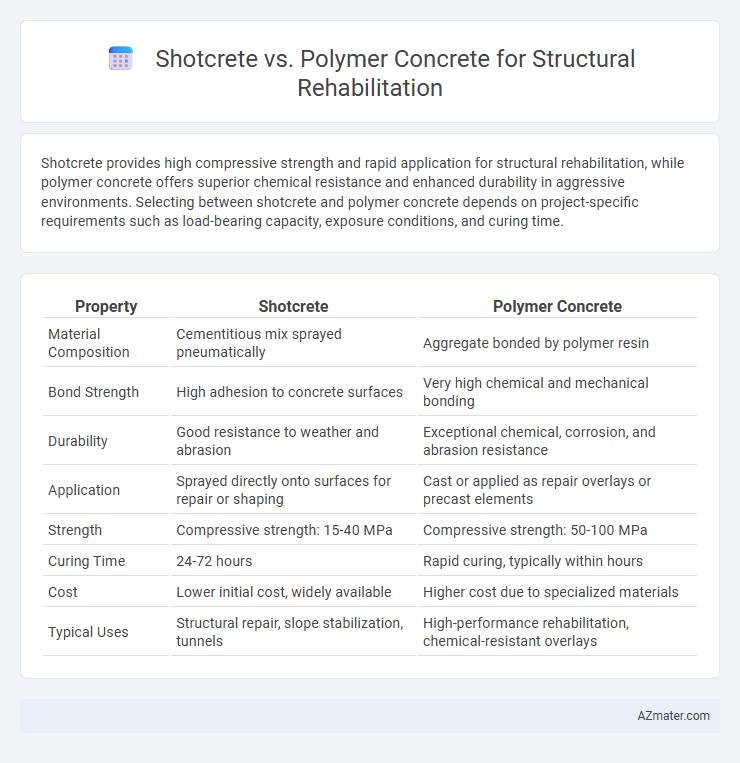Shotcrete provides high compressive strength and rapid application for structural rehabilitation, while polymer concrete offers superior chemical resistance and enhanced durability in aggressive environments. Selecting between shotcrete and polymer concrete depends on project-specific requirements such as load-bearing capacity, exposure conditions, and curing time.
Table of Comparison
| Property | Shotcrete | Polymer Concrete |
|---|---|---|
| Material Composition | Cementitious mix sprayed pneumatically | Aggregate bonded by polymer resin |
| Bond Strength | High adhesion to concrete surfaces | Very high chemical and mechanical bonding |
| Durability | Good resistance to weather and abrasion | Exceptional chemical, corrosion, and abrasion resistance |
| Application | Sprayed directly onto surfaces for repair or shaping | Cast or applied as repair overlays or precast elements |
| Strength | Compressive strength: 15-40 MPa | Compressive strength: 50-100 MPa |
| Curing Time | 24-72 hours | Rapid curing, typically within hours |
| Cost | Lower initial cost, widely available | Higher cost due to specialized materials |
| Typical Uses | Structural repair, slope stabilization, tunnels | High-performance rehabilitation, chemical-resistant overlays |
Introduction to Structural Rehabilitation Materials
Shotcrete and polymer concrete represent advanced materials in structural rehabilitation, offering distinct advantages for restoring and strengthening deteriorated infrastructure. Shotcrete utilizes pneumatically applied concrete, providing excellent adhesion and rapid application, making it ideal for repairing complex geometries and overhead surfaces. Polymer concrete incorporates resin binders that enhance chemical resistance and mechanical properties, ensuring durable repairs in aggressive environments and extending the service life of rehabilitated structures.
Overview of Shotcrete
Shotcrete, a pneumatically applied concrete mixture, is widely used in structural rehabilitation for its high adhesion, rapid setting time, and ability to conform to complex shapes. It offers excellent compressive strength and durability, making it ideal for repairing deteriorated concrete, tunnels, bridges, and retaining walls. The application process allows for minimal formwork, reduced labor costs, and enhanced bond to existing substrates, ensuring effective restoration and reinforcement.
Overview of Polymer Concrete
Polymer concrete is a composite material combining polymer resins with aggregates, offering superior chemical resistance and mechanical strength compared to traditional concrete. It cures rapidly, enabling faster structural rehabilitation with minimal downtime, and exhibits excellent bonding properties on various substrates. This material is ideal for repairing and strengthening deteriorated concrete structures in aggressive environments, providing enhanced durability and longevity.
Key Material Properties Comparison
Shotcrete exhibits high compressive strength and excellent adhesion, making it ideal for quick structural rehabilitation with minimal formwork. Polymer concrete, enhanced with resins like epoxy or polyester, provides superior chemical resistance, low permeability, and enhanced tensile strength, crucial for environments exposed to aggressive chemicals or moisture. Both materials offer rapid curing times, but polymer concrete's durability and elasticity outperform shotcrete in preventing crack propagation in rehabilitated structures.
Application Methods and Techniques
Shotcrete involves pneumatically applying a wet or dry mix of cementitious material using compressed air, allowing for rapid placement on vertical or overhead surfaces during structural rehabilitation. Polymer concrete utilizes resin binders combined with aggregates, typically applied via casting or pumping methods that ensure high adhesion and chemical resistance in repair situations. The choice between shotcrete and polymer concrete depends on the project's required durability, setting time, and surface compatibility in structural applications.
Durability and Longevity
Shotcrete offers exceptional durability due to its dense application and ability to bond well with existing concrete, making it ideal for structural rehabilitation in harsh environments. Polymer concrete enhances longevity by providing superior chemical resistance and reduced permeability compared to traditional cementitious materials, which helps in protecting structures from corrosion and weather-related deterioration. Combining shotcrete with polymer additives can further improve the lifespan of rehabilitation projects by merging the strengths of both materials.
Cost Considerations
Shotcrete offers a cost-effective solution for structural rehabilitation with lower material expenses and faster application times, reducing labor costs significantly. Polymer concrete, while more expensive initially due to higher material costs, provides superior durability and chemical resistance, potentially lowering long-term maintenance and repair expenses. Evaluating total project lifecycle costs is essential to determine the most economical choice between shotcrete and polymer concrete based on specific rehabilitation requirements.
Environmental Impact
Shotcrete offers a lower carbon footprint compared to traditional concrete due to reduced cement content and minimized waste during application, contributing to greener structural rehabilitation practices. Polymer concrete, while providing superior chemical resistance and durability, often relies on synthetic resins derived from non-renewable resources, which may increase environmental concerns related to production and disposal. Choosing shotcrete or polymer concrete requires balancing performance benefits with the sustainability goals of the project, emphasizing material sourcing, lifecycle emissions, and long-term environmental impact.
Performance in Harsh Conditions
Shotcrete exhibits high compressive strength and excellent adhesion, making it effective for structural rehabilitation in harsh conditions with freeze-thaw cycles and chemical exposure. Polymer concrete offers superior chemical resistance and low permeability, providing enhanced durability in aggressive environments such as industrial plants and marine structures. Both materials demonstrate resilient performance, but polymer concrete's enhanced resistance to corrosion and abrasion often makes it the preferred choice for extreme environmental stress.
Choosing the Right Material for Structural Rehabilitation
Selecting the right material for structural rehabilitation depends on factors such as durability, bond strength, and environmental exposure. Shotcrete offers high compressive strength and excellent adhesion for large-scale repairs and complex geometries, making it ideal for concrete structures needing rapid installation and structural reinforcement. Polymer concrete, known for superior chemical resistance and flexible mechanical properties, suits applications requiring enhanced durability against aggressive environments or where lightweight materials are preferred.

Infographic: Shotcrete vs Polymer Concrete for Structural Rehabilitation
 azmater.com
azmater.com